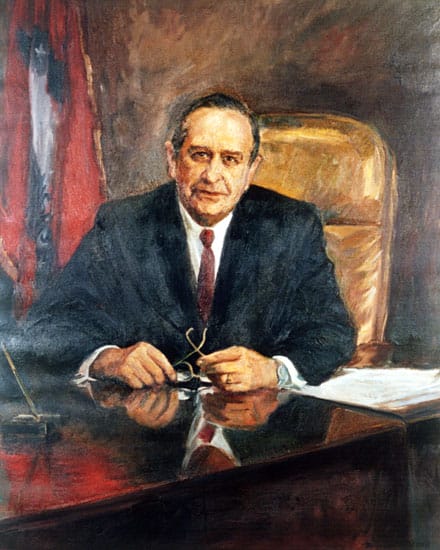

Uh oh...
It appears that you're using a severely outdated version of Safari on Windows. Many features won't work correctly, and functionality can't be guaranteed. Please try viewing this website in Edge, Mozilla, Chrome, or another modern browser. Sorry for any inconvenience this may have caused!
Read More about this safari issue.

December is a time when college football fans look forward to off-season games, but many might not know about the history of bowl games that have taken place in Arkansas. This month in Arkansas history includes football, a somber anniversary and the beginnings of a ghost story, among other interesting historical tidbits.
The Rice and Aluminum Bowls

The first effort to launch a bowl game in Arkansas was in 1956, when the Aluminum Bowl was played at War Memorial Stadium in Little Rock. The game saw Montana State College take on St. Joseph’s College of Indiana in the championship game for the National Association of Intercollegiate Athletics, which governs sports programs at smaller schools.
It was notable for being the first collegiate football championship game played in the state, and may have also been the first racially integrated college football game played in Arkansas. The game was backed by the Aluminum Company of America and Reynolds Metals, and wad broadcast on CBS television and radio stations, but thanks to a rainstorm the event was poorly attended and the game ended in a scoreless tie.
Undaunted, the backers of the World’s Champion Duck Calling Contest decided to sponsor a postseason game known as the Rice Bowl in 1957. The idea was to showcase the talents at smaller schools, with the conference champion from the Arkansas Intercollegiate Conference playing an invited team.
The 1957 game pitted the Arkansas A&M Boll Weevils against the Arkansas Polytechnic College Wonder Boys, and while the game, played at Stuttgart High School, was sold out, many stayed home because of bad weather. The Wonder Boys won 19-7, but the Rice Bowl was troubled because gate receipts were so low they barely covered the expenses for the teams.
Arkansas Tech lost to Louisiana College in the second Rice Bowl in 1958, and East Central (OK) bested Henderson State Teachers College in the final game of the series, played in 1960.
Battle of Prairie Grove

The last major battle of the Civil War fought in Northwest Arkansas was the battle of Prairie Grove, which took place Dec. 7, 1862. The sides were relatively evenly matched, with about 9,000 Union troops and 11,000 Confederate troops fighting in a bloody and savage conflict that left 204 dead on the Confederate side and 175 on the Union side, with more than 800 wounded on each side.
The battle is considered a stalemate, but it reinforced Union control of Northwest Arkansas and southern Missouri. Union Maj. Gen. Samuel Curtis and his men had been camped in and around Cane Hill since an engagement there in late November, while the Confederate Army of the Trans-Mississippi, led by Maj. Gen. Thomas C. Hindman, moved north from Fort Smith and crossed the Arkansas River Dec. 3.
Hearing of the threat from the Confederates, Curtis called on the troops of Brig. Gen. Francis J. Herron, stationed near Springfield, Missouri. Herron’s forces had made it to Fayetteville when the Confederates decided to move past Curtis’ men and meet Herron’s soldiers in between Cane Hill and Fayetteville, which ended up happening at Prairie Grove.
The battle was a pitched back-and-forth battle, with Confederate soldiers defeating the Union cavalry early in the day, a two-hour pounding from Union artillery fire, the Confederates surrounding Union troops on three sides and ultimately retreating after heavy cannon fire drove the Confederates onto the wooded ridge.
The fight is considered the bloodiest day in Arkansas history, and the battle is commemorated with re-enactments every even-numbered year.
The Gurdon Ghost Light

If you’ve lived in Arkansas for long you might have heard the legend of the Gurdon Light, a mysterious light that seems to float over the railroad tracks near that town in Clark County.
The light was first seen in the 1930s, and the story of its origin is linked to a murder that happened near the tracks in December of 1931. Railroad employee Louis McBride, upset about not getting more hours to work, hit foreman William McClain on the head with a shovel and beat him to death.
Legend has it that the light is McClain’s lantern glowing in the dark. This story was made famous in December of 1994, when the television show Unsolved Mysteries aired a program about the light and the story behind it.
Births and Deaths

The first governor of Arkansas, James Sevier Conway, was born Dec. 4, 1796, in Greene County, Tennessee. The family moved to St. Louis in 1818, where Conway learned surveying from his uncle Elias Rector, which would give him work in Arkansas, along with his older brother Henry, who served as the territorial representative to Congress from 1823 until his death in 1827.
He was appointed surveyor general of the state by President Jackson in 1832 and ran for governor of the new state in 1836 as a Democrat, basically running on the power of his national connections, which garnered him more than 61 percent of the vote.
James Philip Eagle, the state’s 16th governor, died Dec. 20, 1904. He served two terms from 1889 to 1893 and died in Little Rock and is buried in Mount Holly Cemetery.
Our 19th governor, Daniel Webster Jones, was born Dec. 15, 1839 and died Dec. 25, 1918. Born in Texas while it was an independent republic, his family bought a plantation and moved to Washington, Arkansas, in 1840. He served as governor from 1897 to 1901. The Governors of Arkansas notes that the former Confederate captain was buried in Oakland Cemetery in Little Rock, wearing a Confederate uniform with an American flag attached.
George Washington Donaghey, the 22nd governor of Arkansas, died Dec. 15, 1937, while our 25th governor, Charles Hillman Brough, died Dec. 26, 1935.The 26th governor, Thomas Chipman McRae, was born Dec. 21, 1851, while Thomas Jefferson Terral, the 27th governor, was born Dec. 21, 1882, and the 28th, John E. Martineau, was born Dec. 2, 1873.
Orval Eugene Faubus, the 36th governor of Arkansas, died Dec. 14, 1994. He is, of course, best known for his role in the Little Rock Central High School crisis over desegregation, but like anyone, there’s a lot more to his story. He was a socialist jailed during World War I for protesting the war. He worked as a teacher and published a newspaper in Madison County. He was in such financial straits in 1977 that he took a job as a bank clerk in Huntsville. He died in Conway and was buried near his family home in Combs.
And our current governor, Asa Hutchinson, was born Dec. 3, 1950, in Bentonville.
We do the work.
You check your email.
Sign up for our weekly e-news.
Get stories sent straight to your inbox!









Like this story? Read more from Sarah White
For this month in Arkansas history, we celebrate the beginning of a large...
June is the month in Arkansas history in which we get to celebrate...
In this month in Arkansas history, we celebrate the birth of several...
Join the Conversation
Leave a Comment